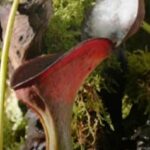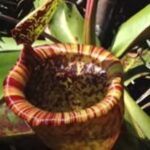As an Amazon Associate, this site earns commissions from qualifying purchases. For more details, click here.
Contrary to popular belief, pitcher plants do not eat insects for food. All these species including nepenthes and sarracenia are capable of making their own through natural means. In this article you will learn how these carnivorous plants make food, why they still eat insects, and why you should feed them if prey is unavailable.
During photosynthesis, a pitcher plant produces a chemical reaction between water and carbon dioxide which creates glucose, or plant food. However, pitcher plants still eat insects to get additional nutrition which is lacking in the soil.
How Pitcher Plants Create Food
When a pitcher plant performs photosynthesis, it absorbs water and carbon dioxide from the soil and atmosphere. The water and carbon dioxide are transmitted into the cells and undergo transformation. The carbon dioxide gets more electrons while water loses some of them.
The changes in the electrons converts carbon dioxide into glucose and water into oxygen. The plant keeps the glucose while oxygen is released into the air.
Whether it is n. mirabilis or other variants, they all use photosynthesis to make glucose, a simple sugar that serves as food. Plants come in all shapes and sizes but their dependence on the sun for food is the same. The photosynthesis process is also similar.
technically glucose is not food, because plants do not digest it the way animals digest food. Some researchers prefer the term fuel since it is more apt. but since glucose performs the same functions as food does for animals, it is generally called plant food.
Why Pitcher Plants Need Glucose
Glucose performs several important functions for pitcher plants. It makes the plants stronger, live longer and be more resistant to disease. Plants cannot live without glucose, period.
- It is used to create starch which plants use as food. Starch is also stored in seeds and necessary for its development.
- Glucose is also used to produce cellulose, which is used to create or fortify cell walls.
- Glucose molecules are a source of carbohydrates for plants.
- When combined with nitrates glucose turns into amino acids. When multiple amino acids combine they produce protein.
Cellular respiration. During evenings or winter, pitcher plants uses cellular respiration to preserve glucose. This is how sarracenia pitcher plants enter dormancy and survive long cold months.
As winter ends and spring approaches, glucose provides fuel for the plant to bloom. This also helps pitcher plants create new leaves and traps.
Think of what healthy food does for humans and you will get the idea. Glucose is essential for any plant -carnivorous or not- for survival. It makes plants more immune to disease and ensures survival in winter.
Why Pitcher Plants Eat Insects
So if glucose does all those things for pitcher plants, why do they eat bugs? Is it even necessary or can these plants live off glucose alone?
Pitcher plants can survive without eating insects. But bugs provide micronutrients and minerals which are absent in the soil. Carnivorous plants are healthier and stronger when they have access to glucose and nutrients.
To better understand this, think of the average houseplant. It depends on sunlight for photosynthesis but it also absorbs nitrogen and other nutrients from the soil. This is why regular plants need rich soil, as sunlight and photosynthesis are not enough.
In an ideal environment the plant gets energy from the sun and nourishment from the soil. Its roots extract nutrients from the soil along with the water. Combined these two provide extra strength for the plant.
The same can be said for pitcher plants. Sunlight is a must and so is glucose. but they also need extra nutrients from the soil. However, carnivorous plants grow in poor conditions where the soil has little to no nutrition available. Carnivorous plants do not grow in fertilized soil. If you want to cultivate nepenthes, use Spring and Stone Carnivorous Soil since it is made specifically for these plants.
Without nutrients from the soil, carnivorous plants have to look for other sources of micronutrients, minerals and nitrogen. Insects are rich sources of these elements and they are plentiful in nature.
Pitcher plants usually grow in bogs, marshes, river beds, swamps etc. Insects rich in nitrogen, iron and other nutrients also call these places home, so they became prey for carnivorous plants. Pitcher plants prey on all kinds of small insects – flying, crawling and foraging – which are attracted to the nectar and its colors.
Other Sources of Nutrients
Insects provide nitrogen and other nutrients, but they are not the only source. Nepenthes ampullaria for instance, is not a bug eater and obtains nutrients from organic leaf debris.
If your nepenthes is always indoors – which is likely because these plants cannot survive winter frost – you can feed them fish beta pellets or frozen worms. Carnivorous plants eat insects because they are aplenty in their environment. But if yours is indoors, fish food or frozen worms are just as good.
The pitchers on pitcher plants are for trapping and eating bugs. However they can also digest freeze dried bloodworms and mealworms. Carnivorous plants – including sarracenia and nepenthes – also have no problems eating fish food.
there are lots of fish food options for carnivorous plants. A particularly good one is Zoo Med Micro Floating Betta Pellets which is as healthy for fish as it is for carnivorous plants.
Feeding pitcher plants is as simple as dropping food into the pitcher. The larger the plant the more food it can handle. But take care not to overfeed the plant.
Pitcher plants exert a lot of effort to catch and eat insects. Pitchers require resources as well as the liquids inside them.
If you overfeed the plant, it might end up using more energy compared to what goes in. If your nepenthes already gets plenty of sunlight, it does not really need a lot of nutrients.
Tips on How to Give Nutrients
If your pitcher plant is outdoors, feeding is not necessary. You can leave the plant in your garden and insects will be drawn to its pitchers. You can also keep nepenthes outdoors during warm weather only. During this period let the plant catch insects on its own.
Move your nepenthes indoors as the temperature drops in the fall and winter. Fish beta pellet and frozen worms will suffice. Make sure the plant is in a warm, humid environment throughout the cold season.
Sarracenia on the other hand requires dormancy so you can leave it outside. Unless your plant is sick, it should have no problems catching prey.
Pitcher plants only need a small amount of nutrients. A bug or two once a week is usually enough. You might see a lot of insects caught in its pitchers, but the plant only digests those it requires. In some cases the plant may try to eat all of them, which is why you have to avoid overfeeding.
How Pitcher Plants Catch Bugs
Whether it is nepenthes x ventrata or another variant, pitcher plants use basically the same mechanisms to catch and consume prey.
Pitcher plants secrete a nectar-like substance which insects and other small animals are drawn to. This substance is located right next to the pitcher. When an insect attempts to sip the nectar, it falls into the trap and is digested.
The edge of the pitcher is slippery due to the nectar. When an ant climbs onto the pitcher, the moistened surface causes it to fall into the pitcher.
Some of these plants have aldehyde crystals, cuticular (a sort of protective film) and scales that make it hard for insets to climb out.
Inside each pitcher is phytotelmata, liquids which drown and dissolve fallen prey. In addition, some pitcher plants nave insect larvae, crab spiders or other animals that consume trapped insects. The remains of these insects are then digested by the plant.
Aside from phytotelmata, pitcher plants may also release additional digestive fluids. These help dissolve prey and turn it into a mixture of urea, amino acids, phosphates and other substances. It is from this solution that pitcher plants absorb phosphorus and nitrogen.
How long it takes to digest insects depends on the health of the plant. If the plant has already met its nutritional requirements then it will take its time eating. It is not unusual for pitchers to contain several insects, but digestion can take a while.
If your pitcher plant is getting enough glucose and sunlight, it will need less food. For the best results however you should make sure it gets both. Combine that with the right amount of watering, humidity, and temperature and your pitcher plants will thrive.

My fascination with carnivorous plants began many, many years ago with Venus Fly Traps. Now I am more than happy to impart what I know with other enthusiasts and those who are curious about meat eating plants.



